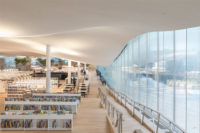“Has ‘The Lighthouse’ Found Support?” boldly queried the Helsinki daily newspaper’s leading headline the morning after the June 23 announcement of the winning entry of the Guggenheim Museum’s year-long, two-phase, open international design competition to produce “a museum for the 21st century” as an extension of its branded franchise operations in the Finnish capital. The competition and its long-awaited result have been aimed at persuasively reinvigorating the Guggenheim’s dogged five-year saga in “the White City of the North,” following the Helsinki City Council’s 2011 rejection of the proposed museum branch and its financing.
The headline’s question neatly condensed several aspects of the immediate state of affairs following the identification of the young Paris-based firm Moreau Kusunoki Architectes as the competition winners with an entry titled “Art in the City,” to be located on the shoreline promenade of the city’s main South Harbor. First, that the winning design’s composition of nine predominantly horizontal, low-profile pavilions, clad in black charred-wood boarding had been reduced in the popular mind to a caricature of its most prominent feature, the vertical “lighthouse (maljakka)” volume anchoring the southern end of the site, which broke the height stipulations set forth by the competition rules. There is precedent in Finnish competitions, at least, for such bending of boundaries, but the design’s evocation of a “lighthouse” on the harbor front appeared a simplistic reduction of the maritime context.
More importantly, the headline and immediate discussion in the Finnish media indicated far less interest in the aesthetics of the winning design, and even less interest in the jury’s suggestion that the entry could produce a more open, egalitarian museum, and more forcefully identified the deeper issues that have dominated the Guggenheim Helsinki project from its inception: deeply divided public opinion on the merits and necessity of such a branded project, profound skepticism on its funding, and demonstrable uncertainty in the political support necessary for any further advancement.
The competition may well revive debate, but the Finnish climate for such imported cultural investment is much changed since 2011. The combined effect of a constrained economy within the European Union – affecting funding for education and social services – as well as recent national elections that reset the political landscape and fiscal priorities, will be challenging to the realization of any design, no matter how well conceived.
While the proposed architecture deserves its assessment, the public and private discussions on the political and financial issues will animate the Finnish capital’s summer holidays, as well as the coming autumn, leading to another sequence of decisive votes by the beginning of next year. The June 24 Helsinki morning newspaper displayed the divided results of an overnight phone survey of the Helsinki City Council members even as members of the Guggenheim Museum’s administration and the Guggenheim-Helsinki Foundation began discussions with both municipal and national officials, advocating the virtues of the new financial models, and using the newly revealed design as an accelerant.
The Guggenheim’s lead statement for the competition press conference declared that “Guggenheim Means Business,” in all of senses of the phrase, it could be assumed. The projection of significant economic development for Helsinki and Finland through the Guggenheim gateway of cultural tourism has its adherents. But the economic and cultural critiques of this perspective are just as available – and just as pithy. Although Finland is not Greece in its economic woes, "Helsinki is not Bilbao,” quipped one city council member, with all-too-predictable irony.









Post a comment to this article
Report Abusive Comment